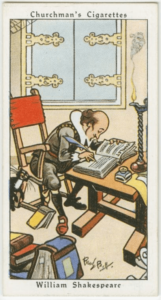“Queer has been defined theoretically as ‘whatever is at odds with the normal, the legitimate, the dominant …, as that which is ‘not yet conscious’ …; as the very status of unthinkability’.”
Clara Bradbury Rance, Lesbian Cinema After Queer Throry, Edinburgh, Edinburgh University Press, 2019, p.10
In my post on this website, Master-Mistress: Love, gender and disguise in Twefth Night, I commented that the main erotic charge in the play is between Viola and Olivia. It has always seemed to me that Olivia is aware that the young man with “Diana’s lip” and the “small pipe” – Orsino’s boy as other characters call her/him – is in fact a woman. In Shakespeare’s England sexuality and desire were far more fluid than they have been since, though the superficial social rules of gender were perhaps more rigid. We know that Shakespeare’s work was remarkable in embracing a wide range of eroticisms. The Sonnets as a sequence includes acute renderings of desire for men, for women (a man, a woman, some might say) and for the androgynous being of Plato’s Symposium. Indeed, i would go so far as to say that one of the abiding tones in Shakespeare’s work, his poetry and his theater, is androgynous, and that one of the most open and productive ways of seeing Shakespeare is through a queer lens.
My purpose in the Master-Mistress post was to explore the ramifications of gender and disguise in the play. While my thinking these days is influenced by the open and fluid framework of queerness, I have not yet formulated a way to write about the nuanced differences this might make to my own writing about the play, so I was pleased to come across an essay by Miranda Fay Thomas in the British Library’s really, really useful online series Discovering Literature: Shakespeare and Renaissance. I will continue to work on a queer discussion of aspcts of Twelfth Night but inthe meantime here is Dr Thomas’ essay:
A Queer Reading of Twelfth Night
2016
Miranda Fay Thomas explores how Twelfth Night interrogates conventional ideas about gender and sexuality, portraying gender as performative and suggesting erotic possibilities between same-sex pairs.
At the end of the film Shakespeare in Love, a heartbroken Shakespeare bids farewell to his lover and immortalises her in a new play that he begins to write as the film credits roll. When he first meets her, she is dressed as a boy as she is determined to act upon the Elizabethan stage despite its ban on female performers. Shakespeare writes his lady into a plot where, once again, she must disguise herself as a man, only to fall in love and be unable to declare it due to her newly assumed gender.
Of course, the plot of Shakespeare in Love is fictional: there is no evidence that Shakespeare based the character of Viola upon a real person. But the film introduces us to one of the key elements of Twelfth Night: the way in which gender can be constructed, or performed, by anyone with the means to do so. However, while Shakespeare in Love toys but briefly with the queerness of Shakespeare having a relationship with a person who dresses as a man, the plot ultimately reinforces heteronormativity (that is, traditional expectations of gender and sexuality) in a way that Twelfth Night more actively questions.
Gender as performance
Because female performers were banned from the English stage in Shakespeare’s day, all of a play’s characters – be they male, female, or somewhere in between – were played by men. While the audience would certainly suspend their disbelief over the actual gender identity of the actors, the effects of this casting should not be underestimated. First of all, it would have inevitably lent an extra frisson to the heterosexual relationships portrayed onstage, which would only be further enhanced by a play like Twelfth Night, where you have a boy actor pretending to be a woman pretending to be a man. But secondly, as Bruce R Smith has noted, it implies that gender,
is more like a suit of clothes that can be put on and taken off at will than a matter of biological destiny … However temporary such cross-dressing may be, it serves to remind audiences that masculinity is a matter of appearances.
When Viola dresses as Cesario, one of their most poignant lines is, ‘I am all the daughters of my father’s house, / And all the brothers too’ (2.4.120–21). Believing her brother to be dead, Viola keeps him alive by dressing in drag and assuming his identity. It is a beautifully genderqueer moment, and different productions of the play may interpret Viola’s gender presentation in a number of different ways. It could be interpreted as a new lifestyle choice, reflecting a truer version of the person that Viola/Cesario is but has never before had the opportunity to present; or more simply, it could be a plot device and part of the means to an end for the play’s storyline of confused lovers. But, as Valerie Traub notes, ‘it is as object of another woman’s desire that Cesario finds her own erotic voice’.[2] When Olivia falls for Cesario, she does so in the full belief of the servant’s masculinity. As famously declared by the gender theorist Judith Butler, ‘there is no gender identity behind the expressions of gender … identity is performatively constituted by the very “expressions” that are said to be its results’.[3] Cesario dresses as a man, and therefore for all intents and purposes is a man in the eyes of the other characters. Cesario is both beloved of Olivia and infatuated with Orsino: gender fluidity, then, serves as the play’s central dramatic irony.
In her introduction to Shakesqueer, Madhavi Menon describes queerness as a concept which, ‘recognizes the absurdity of limits and interrupts the ways in which we live our lives and write our texts’.[4] While it is true that straightness (either in terms of sexual orientation or gender identity) as a category did not fully exist in Shakespeare’s day, some were outspoken against what would now be described as cross-dressing. The prolific pamphleteer Philip Stubbes writes in his Anatomy of Abuses (1584) that:
our apparell was given as a sign distinctive, to discern betwixt sexe and sexe, and therefore one to wear the apparell of an other sex, is to participate with the same and to adulterate the veritie of his own kind.[5]
But of course, that is the whole point of Cesario’s transformation: Twelfth Night depicts one’s gender as essentially a performed role, a simple change of costume marking a change in identity.
Shakespeare’s sources for Twelfth Night
Twelfth Night was written around 1601 and first performed in 1602. Composed at the end of the Elizabethan era, its plot is thought to spring from a number of possible sources, many of which influence Twelfth Night’s fixation with sexual identity and gender. The first of these sources is Plato’s Symposium, where Aristophanes describes the origin of love. Originally, he says, humans were conjoined, with each pair making a complete person. Some of these pairs were both male, some both female, and some partnerships contained a male and a female. However, Zeus decided to punish humans for their arrogance, splitting the creatures down the middle and detaching ourselves from our literal ‘other halves’. At the conclusion of Twelfth Night, Antonio uses language which recalls this story. Upon gazing at the identical twins, Viola and Sebastian, he is agog:
How have you made division of yourself?
An apple cleft in two is not more twin
Than these two creatures. (5.1.223–25)
Barnaby Riche’s Riche his farewell to his military profession (1581), contains a number of stories, the second of which is a source for Twelfth Night: ‘Apolonius and Silla’, a tale of two twins and their respective love interests. Unlike Viola, Silla takes the name of her lost brother, Silvio, when she presents as a different gender. The Italian play Gl’Ingannati has also been noted as a possible source for Twelfth Night. Its similarities of plot were first noted by John Manningham in 1602, whose diary records a performance of Twelfth Night he saw: he commented that it was ‘most like a neere to that Italian called Inganni’, given that the plays share a set of identical twins who are confused with each other. However, unlike Twelfth Night, Gl’Ingannati would have featured women on the Italian stage.
Shakespeare and sexuality
Questions of sexuality in Shakespeare, and indeed questions about Shakespeare’s own sexuality, began scarcely before the ink was dry. While married to Anne Hathaway, who remained in Stratford-upon-Avon throughout Shakespeare’s career in London, he addressed 126 of his sonnets to a young man. And yet as early as 1640, editors were keen to expunge any whiff of homosexuality from the sonnets, with John Benson publishing an edition of the poems with many of the pronouns ‘he’ and ‘his’ revised to ‘she’ and ‘her’. This dismissal of queerness in canonical works of literature, particularly from this period, is not only disappointing and intellectually dishonest; it is also simply inaccurate: labels such as homosexual or heterosexual ‘did not exist as conceptual categories’ at the time Shakespeare was writing.[6] As such, looking for LGBTQ identities in plays such as Twelfth Night enable us to rediscover approaches to gender and sexuality that defy the binaries imposed on Western society since the introduction of the terms ‘homosexual’ and ‘heterosexual’ in the late 19th century. Finding queer love and identity in Shakespeare’s plays would not have been defined as queer back then, but the practice of censoring same-sex relationships in Shakespeare, from Benson and beyond, is still in the process of being righted and re-explored by both critics and performers. Twelfth Night, with its homosexual overtones and its depiction of a character presenting as an alternate gender, is a particularly rich case in point.
Sebastian and Antonio
Let us turn now to the characters of Sebastian and Antonio, described by Stephen Orgel as ‘the only overtly homosexual couple in Shakespeare except for Achilles and Patroclus’.[7] The Renaissance period was keen to promote the strong bonds of male friendships, but the words exchanged between these two characters certainly moves beyond this into the language of erotic love. Antonio says of Sebastian, ‘I do adore thee so / That danger shall seem sport’ (2.1.43–44). The gulf of social status between the two could be one reason for the language of servile devotion, which also occurs in the exchanges between Olivia and Cesario, and Cesario and Orsino; but if the latter two relationships are noted for their erotic charge, we must also consider the possibility of a romance between Sebastian and Antonio. Productions such as Lyndsey Posner’s for the Royal Shakespeare Company in 2001 emphasise such readings, with the two men enacting Act 2, Scene 1 while getting dressed beside an unmade double bed.
The alternate title for Twelfth Night is What You Will, a phrase which nods to a freedom of agency in terms of both sexual orientation and gender identity, while also recalling the name of the playwright himself. We may never know Shakespeare’s own sexual identity, but it doesn’t matter. His works, such as Twelfth Night, remind us that identity itself is relative. If music be the food of love – that is to say, gay love, straight love, queer love, trans love – play on.
Footnotes
[1] Bruce R. Smith, Shakespeare and Masculinity (Oxford: Oxford University Press, 2000), pp. 3–4.
[2] Valerie Traub, The Renaissance of Lesbianism in Early Modern England (Cambridge: Cambridge University Press, 2002), p. 57.
[3] Judith Butler, Gender Trouble (New York and London: Routledge, 2007 [1990]), p. 34.
[4] Madhavi Menon, ‘Queer Shakes’, pp. 1–27 in Shakesqueer: a Queer Companion to the Complete Works of Shakespeare (Durham, N.C., and London: Duke University Press, 2011), p. 7.
[5] Philip Stubbes, The Anatomy of Abuses (London: 1584), p. 38; quoted in Dympna Callaghan, ‘“And all is semblative a woman’s part”: Body Politics and Twelfth Night’, in Twelfth Night: Contemporary Critical Essays, ed. by R S White (Hampshire and New York: Palgrave, 1996), p. 135.
[6] Mario DiGangi, The Homoerotics of Early Modern Drama (Cambridge: Cambridge University Press, 1997), p. 39.
[7] Stephen Orgel, Impersonations: The Performance of Gender in Shakespeare’s England (Cambridge: Cambridge University Press, 1996), p. 51. NB Achilles and Patroclus are from the play Troilus and Cressida.
Link: https://www.bl.uk/shakespeare/articles/a-queer-reading-of-twelfth-night
Sir Toby, in one of his more sober and less cis moments, in the guise of Glenn Havlan, has drawn my attention to the following 2021 article on the London Globe Theatre’s website:
https://www.shakespearesglobe.com/discover/blogs-and-features/2021/02/09/what-you-will-gender-fluidity-in-twelfth-night/?fbclid=IwAR3jtyCRFZ8WKOSUpJQHQ_OYcAY5_Jo-4kPJYqHxusOOruOoxen_lqFp3C4


 As a visual spectacle, The Merry Wives of Windsor is little more than knockabout comedy. It ranges from farce to the subtle humor of gesture. It’s good knockabout, mind you, and despite the preposterous improbability of the plot it is vastly entertaining. Its theater is very domestic and in this respect it can be linked to the comedies of manners of the eighteenth and nineteenth centuries. It abounds in the details of domestic life and as a central theme explores the forces, such as virtue and faithfulness (honesty), that keep daily life on a more-or-less even keel. In the life of the town that is at the center of the play conflict is almost always settled with food. A “hot venison pasty to dinner” is offered as a palliative to Justice Shallow, who fumes that he has been wronged. It is Master Page’s belief that they will “drink down all unkindness.” And at the end of the play, despite the substance of Falstaff’s intrusive campaign against the women, Mistress Page shakes it off and says, “Good husband, let us everyone go home, and laugh this sport o’er by a country fire”.
As a visual spectacle, The Merry Wives of Windsor is little more than knockabout comedy. It ranges from farce to the subtle humor of gesture. It’s good knockabout, mind you, and despite the preposterous improbability of the plot it is vastly entertaining. Its theater is very domestic and in this respect it can be linked to the comedies of manners of the eighteenth and nineteenth centuries. It abounds in the details of domestic life and as a central theme explores the forces, such as virtue and faithfulness (honesty), that keep daily life on a more-or-less even keel. In the life of the town that is at the center of the play conflict is almost always settled with food. A “hot venison pasty to dinner” is offered as a palliative to Justice Shallow, who fumes that he has been wronged. It is Master Page’s belief that they will “drink down all unkindness.” And at the end of the play, despite the substance of Falstaff’s intrusive campaign against the women, Mistress Page shakes it off and says, “Good husband, let us everyone go home, and laugh this sport o’er by a country fire”. 